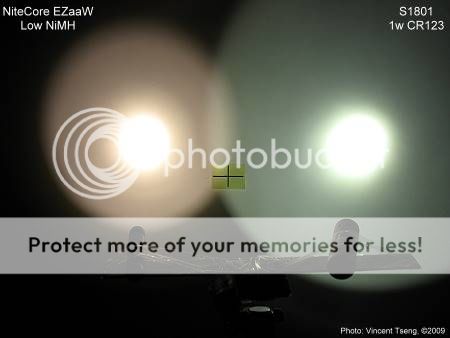Once again through the kind courtesy of 4Sevens I have this NiteCore EZaaW (Warm tint) to look at.
It is basically the NiteCore EZaa but with a warm tint emitter.
But I felt it merited its own review.
Size -

no surprise here it is physically the same as the regular EZaa - if one looks carefully - there is a W designation after the EZ AA
Head -

hmmmm... perhaps the W version shows a bit of brown tint?
Comparison beamshots - using recently charged NiMH (Kodak Pre-Charged)
vs. NiteCore EZ-AA both High NiMH


obvious tint difference - but the brightness looks about the same. The Warm tint is a kind of yellow'ish pale tobacco tint....
vs Fenix L1D-RB100 (my favorite white tint) both high/turbo NiMH


the warm tint makes the RB100 tint look cool in comparison - the EZaaW is brighter.
vs. Streamlight Scorpion Xenon incand 2x CR123


the Scorpion incand is yellower - the EZaaW is obviously brighter - it ought to be, rated at 130 lumens vs. the Scorpion's 60 lumens
The EZaaW on Low -
vs. NiteCore EZ-AA both Low NiMH


again obvious tint difference - but similar brightness levels.
vs. Fenix L1Drb100 both Low NiMH


again obvious tint difference - but similar brightness levels.
vs. Streamlight Scorpion xenon 2x CR123


The Scorpion is brighter - as one would expect - even at this comparison it is still more yellow.
vs. S1801 1w Luxeon 1xCR123 (one of my early favorite tints)


How does the Warmer tint affect color rendition?
Macbeth color rendition chart -





The Warm tint shows up the reds and purples much better - yet still shows the blues well - the RB100 is surprisingly good in this photo comparison.
Please also see:
Puny LED flashlights (Not!) + COLOR RENDITION Comparison
INDEX to Follow-Up Parts -
Foliage beamshot comparison - Post #20
Compaison with LED light filtered through Serengeti Driver sunglasses - Post #26
Discussion of how the eye may prefer warmer tints at lower light levels - Post #33
Standardized Stairway beamshot comparison - Post #34
Color removed by deSaturation comparison between the EZaaW and regular cool white EZaa - Post #40
EZaaW uses mainly the Q3 5B - with illustration of the binning - Post #41
It is basically the NiteCore EZaa but with a warm tint emitter.
But I felt it merited its own review.
Size -

no surprise here it is physically the same as the regular EZaa - if one looks carefully - there is a W designation after the EZ AA
Head -

hmmmm... perhaps the W version shows a bit of brown tint?
Comparison beamshots - using recently charged NiMH (Kodak Pre-Charged)
vs. NiteCore EZ-AA both High NiMH


obvious tint difference - but the brightness looks about the same. The Warm tint is a kind of yellow'ish pale tobacco tint....
vs Fenix L1D-RB100 (my favorite white tint) both high/turbo NiMH


the warm tint makes the RB100 tint look cool in comparison - the EZaaW is brighter.
vs. Streamlight Scorpion Xenon incand 2x CR123


the Scorpion incand is yellower - the EZaaW is obviously brighter - it ought to be, rated at 130 lumens vs. the Scorpion's 60 lumens
The EZaaW on Low -
vs. NiteCore EZ-AA both Low NiMH


again obvious tint difference - but similar brightness levels.
vs. Fenix L1Drb100 both Low NiMH


again obvious tint difference - but similar brightness levels.
vs. Streamlight Scorpion xenon 2x CR123


The Scorpion is brighter - as one would expect - even at this comparison it is still more yellow.
vs. S1801 1w Luxeon 1xCR123 (one of my early favorite tints)


How does the Warmer tint affect color rendition?
Macbeth color rendition chart -





The Warm tint shows up the reds and purples much better - yet still shows the blues well - the RB100 is surprisingly good in this photo comparison.
Please also see:
Puny LED flashlights (Not!) + COLOR RENDITION Comparison
INDEX to Follow-Up Parts -
Foliage beamshot comparison - Post #20
Compaison with LED light filtered through Serengeti Driver sunglasses - Post #26
Discussion of how the eye may prefer warmer tints at lower light levels - Post #33
Standardized Stairway beamshot comparison - Post #34
Color removed by deSaturation comparison between the EZaaW and regular cool white EZaa - Post #40
EZaaW uses mainly the Q3 5B - with illustration of the binning - Post #41
Last edited:



